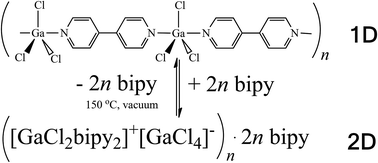Versatile structures of group 13 metal halide complexes with 4,4′-bipy: from 1D coordination polymers to 2D and 3D metal–organic frameworks†
Abstract
A systematic structural study of complexes formed by aluminium and gallium trihalides with 4,4′-bipyridine (bipy) in 2 : 1, 1 : 1, and 1 : 2 stoichiometric ratios has been performed. Molecular structures of 11 complexes in the solid state have been determined for the first time. Complexes of 2 : 1 composition are molecular, while complexes of 1 : 1 composition form metal–organic frameworks of different kinds: an ionic 3D network (three interpenetrated lvt nets for AlCl3bipy), an ionic 2D network for AlBr3bipy and GaBr3bipy and a 1D coordination polymer in the case of GaCl3bipy. Thus, the nature of the Lewis acid plays a critical role in the structural type of the complex in the solid state. Incorporation of excess bipy molecules into (GaCl3bipy)∞ (formation of crystallosolvate) leads to an unprecedented change of the molecular structure from a non-ionic 1D coordination polymer to an ionic 2D metal organic framework [GaCl2bipy2]+[GaCl4]−·2bipy. As indicated by the temperature-dependent XRD study, removal of bipy by heating in a vacuum restores the non-ionic 1D structure. Quantum chemical computations for simple cluster model systems (up to eight Al and Ga atoms) reveal that ionic forms are slightly favourable, although the energy differences between the ionic and non-ionic structures are not large. These theoretical predictions are in good agreement with experimental findings. Thus, even relatively simple cluster models may be used to indicate the structural preferences in the solid state. Both experimental and computational IR frequency shifts of the in-plane ring bending mode of bipy upon complexation correlate well with the M–N bond distances in the complexes.


 Please wait while we load your content...
Please wait while we load your content...